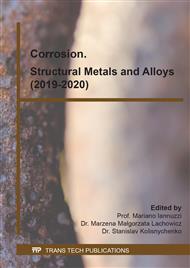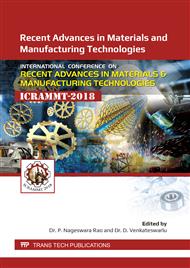[1]
P.Marshall, Austenitic Stainless Steels Microstructure and Mechanical Properties, first ed., Elsevier applied science publishers, England, (1984).
Google Scholar
[2]
B. Larsson, U. Lundell, and S. Bukovinsky, Special stainless steels for the process industry, Mater. Des. 6 (6) (1985) 306–312.
DOI: 10.1016/0261-3069(85)90013-5
Google Scholar
[3]
U. Kamachi Mudali et al., On the pitting corrosion resistance of nitrogen alloyed cold worked austenitic stainless steels, Corros. Sci. 44 (10) (2002) 2183–2198.
DOI: 10.1016/s0010-938x(02)00035-5
Google Scholar
[4]
B. Ravi Kumar, B. Mahato, and R. Singh, Influence of Cold-Worked Structure on Electrochemical Properties of Austenitic Stainless Steels, Metall. Mater. Trans. A 38 (9) (2007) 2085–(2094).
DOI: 10.1007/s11661-007-9224-4
Google Scholar
[5]
I. Olefjord and B.O. Elfstrom, The composition of the surface during passivation of stainless steels, Corrosion 38 (1) (1982) 46–52.
DOI: 10.5006/1.3577318
Google Scholar
[6]
K. Asami, K. Hashimoto, and S. Shimodaira, An ESCA study of the Fe2+/Fe3+ ratio in passive films on iron-chromium alloys, Corros. Sci. 16 (6) (1976) 387–391.
DOI: 10.1016/0010-938x(76)90125-6
Google Scholar
[7]
H. Ogawa et al., Auger Electron Spectroscopic and Electrochemical Analysis of the Effect of Alloying Elements on the Passivation Behavior of Stainless Steels, Corrosion 34 (2) (1978) 52–60.
DOI: 10.5006/0010-9312-34.2.52
Google Scholar
[8]
C.M. Rangel, T.M. Silva, and M. da C. Belo, Semiconductor electrochemistry approach to passivity and stress corrosion cracking susceptibility of stainless steels, Electrochim. Acta 50 (25–26) (2005) 5076–5082.
DOI: 10.1016/j.electacta.2005.03.064
Google Scholar
[9]
S. Lozano-Perez et al., Multi-scale characterization of stress corrosion cracking of cold-worked stainless steels and the influence of Cr content, Acta. Mater. 57 (18) (2009) 5361–5381.
DOI: 10.1016/j.actamat.2009.07.040
Google Scholar
[10]
LvJinlong and L. Hongyun, Effects of strain and strain-induced α'-martensite on passive films in AISI 304 austenitic stainless steel, Mater. Sci. Eng. C 34 (0) (2014) 484–490.
DOI: 10.1016/j.msec.2013.10.003
Google Scholar
[11]
L. Jinlong and L. Hongyun, Electrochemical investigation of passive film in pre-deformation AISI 304 stainless steels, Appl. Surf. Sci. 263 (0) (2012) 29–37.
DOI: 10.1016/j.apsusc.2012.08.058
Google Scholar
[12]
S. V Phadnis et al., Comparison of rolled and heat treated SS304 in chloride solution using electrochemical and XPS techniques, Corros. Sci. 45 (11) (2003) 2467–2483.
DOI: 10.1016/s0010-938x(03)00099-4
Google Scholar
[13]
N.T. McDevitt and W.L. Baun, Infrared absorption study of metal oxides in the low frequency region (700-240 cm−1), Spectrochim. Acta 20 (5) (1964) 799–808.
DOI: 10.1016/0371-1951(64)80079-5
Google Scholar



